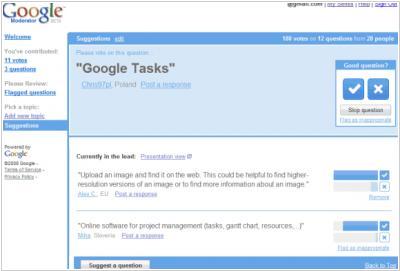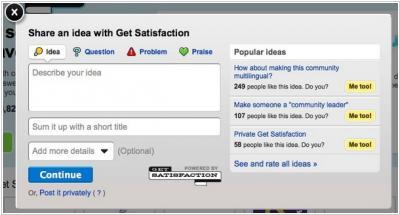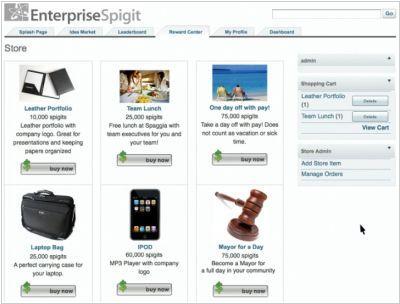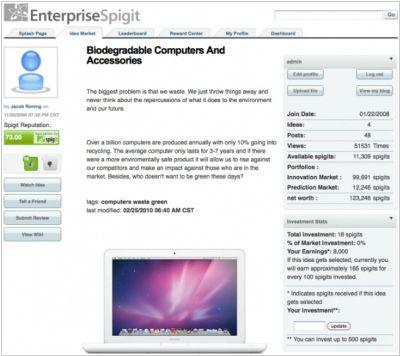Idea management 2.0: from Get Satisfaction to Spigit
May 31, 2010 | Author: Adam Levine
We all understand the growing role of talent in the modern enterprise. To help companies better use their talents, IT vendors have created the new class of Talent management systems. In addition to it another class of Idea management systems is emerging now. Idea - is the main talent's product. Idea can be worth millions, and raise the business to a new level. At the same time each day business executives don't notice (or forget) plenty of ideas coming from clients or their own staff. This is especially actual for large companies - even if you have a brilliant idea - the chance to be noticed is minimal. Idea (or innovation) management systems tend to solve this problem and convert ideas into money (as for those who creates them, and for those who use them).
Google Moderator

Google Moderator - this is one of the least-known services in Google Apps, which is specifically designed to collect ideas and questions. In particular, this service was used to collect questions to Barack Obama during his Youtube conference. You create a topic, invite participants, then you can publish it on your site (or in Google Wave). Visitors can add ideas or vote for the already added ideas. Most popular ideas float up. For every idea comments can be added. The topic owner, of course, can moderate it. The disadvantage is that the visitor (to participate) must have Google-account. But with the help of Google Moderator API this problem can be solved.
Other solutions

Public idea aggregators (SuggestionBox, FeVote, Featurelist) besides collecting and rating ideas, give an opportunity to promote your company. If your customers generate a lot of ideas - you get to the home page and get more traffic.
Often the idea collection is included in customer support services (along with the collection of bugs, questions and reviews). The most famous representatives of this segment are Get Satisfaction, Salesforce Ideas, UserVoice.
Finally, there is a number of solutions that support the entire idea life cycle management - from capturing to implementation. On top of this segment are Kindling, Brightidea and Spigit.
Spigit

When ideas usually appear? In the evening at home or on the way to work. Spigit provides the mobile client so you can capture the idea until it's forgotten. In order not to login to Spigit every time, it's integrated with Sharepoint. To describe the idea you can use pictures, video, files.

Voting for the ideas in Spigit is based on the reputation system. If you have a high reputation - your vote will not cost 1, but, for example, 50 points. In addition to reputation, for ideas you can get investments (in internal currency) from management and colleagues. For this currency you can buy iPod, a day off with pay, or a ticket to Canaries - these "goods" are sold in the Spigit reward store. You can invest in other people's ideas and receive dividends if these ideas are qualified.

Once the best ideas are identified Spigit helps to organize collaboration to implement them. Every idea has its dashboard, wiki, blog, files, team list. And the author (employee or client) can monitor idea's status and assist in its implementation.
Google Moderator

Google Moderator - this is one of the least-known services in Google Apps, which is specifically designed to collect ideas and questions. In particular, this service was used to collect questions to Barack Obama during his Youtube conference. You create a topic, invite participants, then you can publish it on your site (or in Google Wave). Visitors can add ideas or vote for the already added ideas. Most popular ideas float up. For every idea comments can be added. The topic owner, of course, can moderate it. The disadvantage is that the visitor (to participate) must have Google-account. But with the help of Google Moderator API this problem can be solved.
Other solutions

Public idea aggregators (SuggestionBox, FeVote, Featurelist) besides collecting and rating ideas, give an opportunity to promote your company. If your customers generate a lot of ideas - you get to the home page and get more traffic.
Often the idea collection is included in customer support services (along with the collection of bugs, questions and reviews). The most famous representatives of this segment are Get Satisfaction, Salesforce Ideas, UserVoice.
Finally, there is a number of solutions that support the entire idea life cycle management - from capturing to implementation. On top of this segment are Kindling, Brightidea and Spigit.
Spigit

When ideas usually appear? In the evening at home or on the way to work. Spigit provides the mobile client so you can capture the idea until it's forgotten. In order not to login to Spigit every time, it's integrated with Sharepoint. To describe the idea you can use pictures, video, files.

Voting for the ideas in Spigit is based on the reputation system. If you have a high reputation - your vote will not cost 1, but, for example, 50 points. In addition to reputation, for ideas you can get investments (in internal currency) from management and colleagues. For this currency you can buy iPod, a day off with pay, or a ticket to Canaries - these "goods" are sold in the Spigit reward store. You can invest in other people's ideas and receive dividends if these ideas are qualified.

Once the best ideas are identified Spigit helps to organize collaboration to implement them. Every idea has its dashboard, wiki, blog, files, team list. And the author (employee or client) can monitor idea's status and assist in its implementation.
See also: Top 10 Enterprise Social Software


